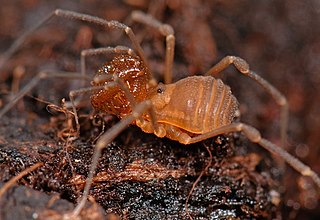
The Opiliones are an order of arachnids, colloquially known as harvestmen, harvesters, harvest spiders, or daddy longlegs. As of July 2024, over 6,650 species of harvestmen have been discovered worldwide, although the total number of extant species may exceed 10,000. The order Opiliones includes five suborders: Cyphophthalmi, Eupnoi, Dyspnoi, Laniatores, and Tetrophthalmi, which were named in 2014.

Samooidea is a large superfamily in the Grassatores group of harvestmen. It includes around 380 species distributed throughout the tropics. They are characterized by the complex male genitalia, with eversible complementary sclerites.

Cosmetidae is a family of harvestmen in the suborder Laniatores. With over 700 species, it is one of the largest families in Opiliones. They are endemic of the New World with a Nearctic-Neotropical distribution where a large fraction of the diversity of Opiliones are represented by this single family. Cosmetidae have the northern extent of their range into the USA, where a small number species occur in the southern states. However, the family is especially diverse in Mexico, Central America and northern South America; especially the Andean realms. Their range also extends further south into Argentina and southern Brazil, but they are absent in Chile. Cosmetidae are prevalent in Amazonian region, but only relatively few also occur in Brazilian Atlantic Forest. Several species are also found in the Caribbean.

The Phalangodidae are a family of harvestmen with about 30 genera and more than 100 described species, distributed in the Holarctic region.

Ischyropsalididae is a family of harvestmen with 35 described species in 3 genera, found in Europe and North America.
The Stygnopsidae are a small family of harvestmen, with almost all species found in Mexico.

The Cranaidae are a family of neotropical harvestmen within the suborder Laniatores.
Kimulidae is a small neotropical family of the harvestman infraorder Grassatores with about thirty described species.

The Travuniidae are a small family of harvestman with little more than ten described species, within the suborder Laniatores.

Cryptomaster is a genus of armoured harvestmen in the family Cryptomastridae. There are two described species in Cryptomaster, both found in Oregon.

Theromaster is a genus of armoured harvestmen in the family Cladonychiidae. There are at least two described species in Theromaster, found in the eastern United States.

Travunioidea is a superfamily of armoured harvestmen in the order Opiliones. There are 4 families and around 75 described species in Travunioidea.
Enigmina is a genus of armoured harvestmen in the family Phalangodidae. There are at least two described species in Enigmina.

Isolachus is a genus of armoured harvestmen in the family Cladonychiidae. There is one described species in Isolachus, I. spinosus, found in Oregon and Washington.

Paranonychus is a genus of harvestman in the family Paranonychidae. There are at least three described species in Paranonychus.

Megacina is a genus of armoured harvestmen in the family Phalangodidae. There are at least four described species in Megacina.

Briggsus is a genus of armoured harvestmen in the family Cladonychiidae. There are about five described species in Briggsus, found in the coastal forests of Oregon and Washington.

Holoscotolemon is a genus of armoured harvestmen in the family Cladonychiidae. There are about eight described species in Holoscotolemon, found in Europe.
Metanonychus is a genus of harvestman in the family Paranonychidae. There are eight described species in Metanonychus, found in the northwestern United States.

Peltonychia is a genus of armoured harvestmen in the family Cladonychiidae. There are about nine described species in Peltonychia that are found in Europe.














